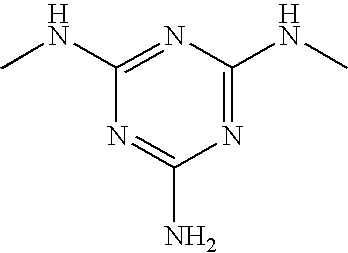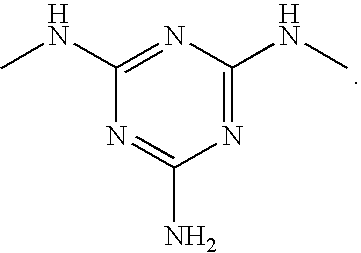Colored ink for pad transfer printing of silicone hydrogel lenses
- Summary
- Abstract
- Description
- Claims
- Application Information
AI Technical Summary
Benefits of technology
Problems solved by technology
Method used
Image
Examples
example 1
Synthesis of Silicone-Containing Macromer
[0105] 51.5 g (50 mmol) of the perfluoropolyether Fomblin® ZDOL (from Ausimont S.p.A, Milan) having a mean molecular weight of 1030 g / mol and containing 1.96 meq / g of hydroxyl groups according to end-group titration is introduced into a three-neck flask together with 50 mg of dibutyltin dilaurate. The flask contents are evacuated to about 20 mbar with stirring and subsequently decompressed with argon. This operation is repeated twice. 22.2 g (0.1 mol) of freshly distilled isophorone diisocyanate kept under argon are subsequently added in a counterstream of argon. The temperature in the flask is kept below 30° C. by cooling with a waterbath. After stirring overnight at room temperature, the reaction is complete. Isocyanate titration gives an NCO content of 1.40 meq / g (theory: 1.35 meq / g).
[0106] 202 g of the α,ω-hydroxypropyl-terminated polydimethylsiloxane KF-6001 from Shin-Etsu having a mean molecular weight of 2000 g / mol (1.00 meq / g of hy...
example 2
Synthesis of a Silicone-Containing Binder Polymer
[0109] A binder polymer is prepared in a single batch as follows. A mixture of components listed in Table 1 is reacted at 40° C. under nitrogen flow.
TABLE 1BinderNo.HEMATRISDMAV68EtSHAcetoneEthanol1035.588.900.200.32055.00208.9035.580.200.32055.00319.4119.4120.000.260.42040.50418.1718.1718.170.250.2445.000514.9413.9420.920.200050.00617.4312.9519.420.200050.00719.9211.9517.930.200050.00822.4110.9216.470.200050.00917.4312.9519.420.200050.001014.6814.6815.120.200.32055.001120.7615.4223.130.200.48040.00
TRIS = tristrimethylsilyloxysilylpropyl methacrylate;
V68 = 4,4-azobis-4-cyanovaleric acid;
EtSH = ethyl mercaptan
Ink Preparation
[0110] Inks are prepared by mixing a binder polymer solution obtained above without separation and purification of the synthesized binder polymer with other components according the formulation shown in Table 2.
TABLE 2BinderInk No.No.DiluentHDIPigment14HEMAYes1.74% PCN blue22Acetone02.60% PCN blue31Ethano...
example 3
Synthesis of a Silicone-Containing Binder Polymer
[0115] A binder polymer is prepared in a single batch as follows. A mixture of 20.38% of HEMA, 14.87% of TRIS, 22.10% of DMA, 0.19% of Vazo 64, 0.33% of EtSH, 42.13% of cyclopentanone is reacted at 40° C. under nitrogen flow.
Ink Preparation
[0116] Activation formulations are prepared by mixing components listed in Table 4. Inks are prepared by mixing (1) a binder polymer solution obtained above without separation and purification of the synthesized binder polymer from other unreactive components; and (2) other components (pigment Mearlin Microrusset 9450M from Engelhard, cyclopentanone, activation formulation listed in Table 4) according the formulation shown in Table 5.
TABLE 4Activation No.123HEMA29.633.628.2TRIS22.024.821.0DMA33.437.831.8HDI15.000Darocur 117303.819.0
[0117]
TABLE 5Ink No.171819Binder polymer55.850.855.8Cyclopentanone8.49.38.4Pigment8.89.98.9Activation #126.800Activation #2030.00Activation #30026.9
Lens-Forming M...
PUM
| Property | Measurement | Unit |
|---|---|---|
| Fraction | aaaaa | aaaaa |
| Fraction | aaaaa | aaaaa |
| Fraction | aaaaa | aaaaa |
Abstract
Description
Claims
Application Information
 Login to View More
Login to View More - R&D
- Intellectual Property
- Life Sciences
- Materials
- Tech Scout
- Unparalleled Data Quality
- Higher Quality Content
- 60% Fewer Hallucinations
Browse by: Latest US Patents, China's latest patents, Technical Efficacy Thesaurus, Application Domain, Technology Topic, Popular Technical Reports.
© 2025 PatSnap. All rights reserved.Legal|Privacy policy|Modern Slavery Act Transparency Statement|Sitemap|About US| Contact US: help@patsnap.com



